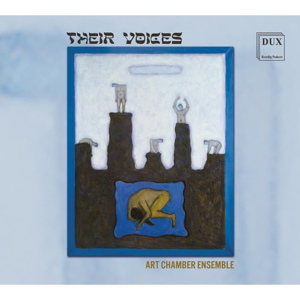
Their Voices
Joseph Achron (1886-1943)
Hebrew Melody, Op.33 (1911)
Joachim Mendelson (1897-1943)
Violin Sonata (1937)
Szymon Laks (1901-1983)
Cello Sonata (1932)
Józef Koffler (1896-1944)
Capriccio, for violin and piano, Op.18 (c.1936)
Benjamin Lees (1924-2010)
Piano Trio No.2 Silent Voices (1998)
Art Chamber Ensemble
rec. 2022, Concert Hall of the Karol Lipiński Academy of Music in Wrocław, Poland
DUX 1889 [61]
The Polish-Jewish nature of this programme is very clear. Benjamin Lees is the outlier, an American, but his Second Piano Trio Silent Voices was performed at the Holocaust Museum in Washington D.C. at a concert dedicated to the music of émigré Jewish composers.
Though Achron is best-known for having studied with Auer in St Petersburg his Hebraic music is his greatest legacy to the repertoire – he was a pioneering member of the Society of Jewish Folk Music and wrote his Hebrew Melody shortly after joining the group. This is played by violinist Jarosław Pietrzak and pianist Julita Przybylska-Nowak with a lingering, reverential poise, which means that their performance is the slowest I can remember. Performances on 78 habitually cut small passages, including a cadential one. What this performance loses in the ethnic melancholia of a performance by, say, Josef Hassid, it gains in a sense of cosmopolitan musing. So, if cosmopolitan musing is your thing, here it is. I prefer otherwise, as Otto K once sagely remarked.
Joachim Mendelson’s Violin Sonata has been recorded before but it makes sense to site it in this programme. It has the freshness and textual clarity of the French School, a tart neo-classicism with inbuilt dissonances, but also a boulevardier brio that’s very appealing. The first movement is also songful and lyrical – sometimes just a little too much for its own good – but the slow movement is refined and clear, and the finale lightly puckish.
The music of Szymon Laks has been heard increasingly often in the last decade and his Cello Sonata makes a welcome appearance here, played by Agnieszka Kołodziej and Przybylska-Nowak. It, too, is Francophile in stylist orientation, with crisp pizzicati, a sense of chamber bigness at the end of the first movement, and a just distribution of material between the two instruments. There’s a songful, bluesy central slow movement and a capriciously off-beat, lissome and witty finale – qualities made the more so by virtue of this assured performance.
The brief Capriccio for violin and piano by Józef Koffler was written in the mid-1930s, so compositionally bisects the Mendelson and Laks sonatas. It’s a kind of perpetuum mobile with elements of absorbed 12-tone.
Lees’s trio is a one-movement work with taut, fractured voices that are subject to some brusque outbursts. Whether urgent or insistent, it rises to a pitch of intensity at around the 12-minute mark after which a sorrowful, keening element takes over. It’s a fine work, fully deserving of its place here, and much more than a modern pendant, more a reflection on the music already heard.
The Art Chamber Ensemble plays with admirable assurance throughout, either collectively or in the sonatas, though as I noted earlier, I wish the Achron had been more Hebraically inflected. Never mind, the programme is finely recorded, very decently documented, and warmly played.
Jonathan Woolf
Help us financially by purchasing from




















